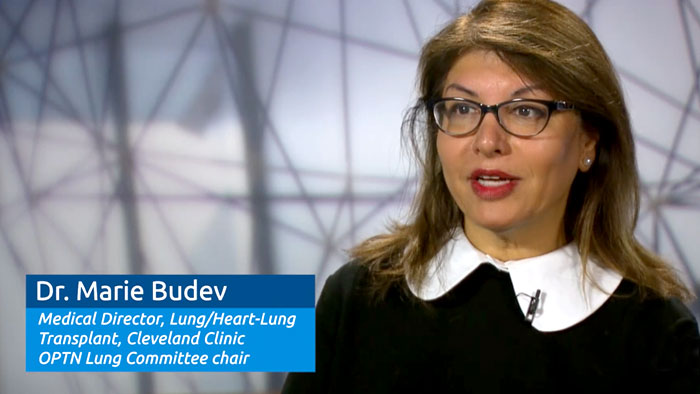Approach uses the new continuous distribution framework to save more lives.
Earlier this month, United Network for Organ Sharing (UNOS) launched a new lung allocation policy that will increase equitable access for patients who are in greatest need of a lung transplant while decreasing the overall number of patient deaths on the national waitlist. UNOS is the non-profit that contracts with the federal government to serve as the nation’s Organ Procurement and Transplantation Network (OPTN).
Dr. Marie Budev, the OPTN Lung Transplantation Committee Chair, explains lung continuous distribution and how patients on the transplant waitlist benefit.
Developed with the help of the Massachusetts Institute of Technology (MIT), RTI International (RTI) and the Scientific Registry of Transplant Recipients (SRTR), this policy is the first to use continuous distribution, which will become the standard for kidneys, pancreases, hearts, livers and other types of organ transplants in the future.
This new, dynamic framework relies on a more holistic view of each patient, dissolves rigid boundaries that exist in the current, category-based system, and ensures that no single factor determines a patient’s priority on the waitlist.
Donor lungs will now be allocated based on a unique composite score developed for each patient. This score will be based on a variety of factors, including illness severity, biology, expected time of life after transplant and more.
“This innovative new system will be more equitable and patient-focused,” said Marie Budev, D.O., M.P.H., who serves as chair of the OPTN Lung Transplantation Committee, which spearheaded the policy development. “Instead of considering the many factors that define a candidate’s unique need for an organ sequentially, we can now consider them all simultaneously for each patient.”
Researchers from MIT’s Sloan School of Management assisted the committee in developing the continuous distribution framework by applying artificial intelligence (AI) and machine learning to evaluate the effectiveness of millions of different policy scenario options. RTI contributed analysis, and the SRTR performed simulation modeling to validate results, remaining involved throughout the policy framework’s implementation.
James Alcorn, UNOS senior policy strategist, explains how the continuous distribution framework was developed.
“Continuous distribution is a generational change in the field of organ allocation,” said James Alcorn, senior policy strategist at UNOS. “We were able to build a system that’s much nimbler than before, allowing us to identify issues and implement solutions much more quickly in the future.”
As part of the policy development process, a diverse group of nearly 200 individuals representing a wide range of experiences and perspectives in donation and transplant, including patients, took part in an exercise where they shared what factors they considered most important when developing the composite score.
Similar to how one turns a dial, the committee can now easily adjust the weights on the scale to further optimize the allocation system when policy changes are approved. “Take pediatric priority, for example. When we identify a certain patient group that is not appropriately prioritized, we can quickly identify the attribute they share in the system, and then adjust its weight to improve the entire system,” Alcorn said.
Statistical modeling predicts that the new lung policy will not only reduce the number of patients who die waiting for a lung transplant but will also increase access to transplants for patients in need, including those with the most severe illness. A recent study by the Cleveland Clinic, in partnership with the SRTR, found that across all modeling scenarios, “the system led to improved overall measures of equity” when compared to the previous system.
UNOS has hosted multiple webinars and provided resources to support patients, physicians and other donation and transplant professionals during the transitional phase. To date, hundreds of individuals have attended these public webinars. Additionally, UNOS has created patient materials that address questions for candidates on the waiting list.
The OPTN Board of Directors unanimously approved the policy in December 2021. The OPTN Lung Transplantation Committee will actively monitor the new lung policy and, if needed, make recommendations for additional improvements.
Work to transition all other organ types to the continuous distribution framework is proceeding, with kidney and pancreas policies anticipated next.

